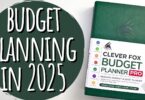Managing your finances can feel overwhelming at times, especially when you’re juggling multiple bills, savings goals, and spending habits. One powerful way to take control of your financial situation is by creating a budget binder. Whether you’re looking to save money, organize bills, or get on top of your monthly expenses, a budget binder can provide the structure and clarity you need to succeed.
A budget binder is a simple, yet effective tool that helps you visualize your financial goals, track progress, and maintain accountability. By keeping everything in one place, you eliminate the guesswork from budgeting, allowing for more strategic decision-making. Ready to create your own budget binder and start saving money? Let’s dive in!
What is a Budget Binder?
A budget binder is a physical or digital system designed to help you organize your finances. Typically, it contains sections dedicated to tracking income, expenses, savings, debts, and financial goals. The binder offers a bird’s-eye view of your financial life, making it easier to identify where you can cut costs, save money, and allocate resources more effectively.
By maintaining an organized budget binder, you’ll be able to see where every penny goes, set long-term savings goals, and avoid unnecessary spending. Plus, the act of writing down your budget helps reinforce financial discipline and encourages regular check-ins with your progress.
Why You Need a Budget Binder
Using a budget binder is essential if you’re serious about achieving your financial goals. Here are a few reasons why you should consider creating one:
- Track Your Spending: A budget binder helps you keep track of where your money is going. It’s easier to save money when you can clearly see your spending patterns and make informed decisions.
- Organize Financial Documents: Keep all your important receipts, bills, and statements in one place for easy reference.
- Achieve Financial Goals: By writing down your goals and monitoring progress, you can stay focused and motivated.
- Reduce Stress: A budget binder can alleviate financial anxiety by providing clarity and control over your finances.
- Save Money: When you know where your money is going, you can make smarter choices to reduce expenses and build your savings.
How to Create a Budget Binder Step-by-Step
Creating a budget binder is easier than you might think. Follow these steps to build a system that works for you.
Step 1: Gather Supplies
To get started, you’ll need a few basic materials:
- A three-ring binder (1-2 inches thick)
- Dividers to separate each section
- Plastic sleeves for receipts and bills
- Lined paper or printed budget templates
- A pen or set of colorful markers for labeling
- Optional: stickers or highlighters for added organization
You can personalize your budget binder by choosing a design or color that inspires you, making the process more enjoyable and motivating.
Step 2: Create Sections for Your Binder
Once you’ve gathered your supplies, it’s time to set up the sections for your budget binder. Here are a few common sections to include:
- Monthly Budget: This section should include your income, fixed expenses, variable expenses, and savings for each month.
- Expense Tracker: Track your daily, weekly, or monthly spending to see where your money is going.
- Bill Payment Log: Keep a list of all the bills you owe, along with their due dates and amounts.
- Savings Goals: Write down your short-term and long-term savings goals, along with a progress tracker.
- Debt Tracker: If you’re working on paying off debt, use this section to track your payments and remaining balances.
- Receipts/Statements: Store important receipts, bank statements, and other financial documents here for easy reference.
Step 3: Customize Your Budget Binder
No two budget binders are the same, and that’s the beauty of it! You can customize your binder to fit your personal financial needs. For example, you might want to add:
- Meal Planning: If meal planning is part of your money-saving strategy, include a section for planning weekly menus and grocery lists.
- Emergency Fund: Create a section to track your progress in building an emergency fund, which can serve as a financial safety net.
- Income Tracker: If you have multiple income streams (such as a side gig or freelance work), this section will help you keep tabs on them.
Step 4: Fill in the Details
Now that your binder is set up, it’s time to start filling it out. Begin by listing your monthly income, including any wages, freelance earnings, or other forms of income. Next, list your fixed expenses (rent, utilities, insurance) and variable expenses (groceries, entertainment, gas). Don’t forget to include your savings goals as well.
One helpful tip is to fill out your budget binder at the start of every month and update it weekly. This habit ensures you stay on top of your spending and adjust your budget as needed.
Budget Binder: A Tool to Save Money
One of the primary benefits of using a budget binder is its ability to help you save money. By tracking your spending and staying organized, you’re less likely to overspend or forget about upcoming bills. A budget binder gives you a clear picture of your financial health and encourages better spending habits.
For example, by keeping a close eye on your utility bills or grocery expenses, you can identify areas where you’re overspending and make adjustments. You can also track subscriptions or services you no longer use and cancel them, saving yourself even more money.
A budget binder also encourages accountability. Seeing your financial goals written out can be a powerful motivator to avoid impulse purchases and stick to your budget. With regular updates and check-ins, you’ll quickly see the impact of these small changes in your overall financial situation.
Tips for Making the Most of Your Budget Binder
Using a budget binder is a powerful tool, but like any tool, it works best when used consistently. Here are some tips to ensure you make the most of your budget binder:
- Update Regularly: Set aside time each week to review and update your budget binder. Consistency is key to staying on track with your financial goals.
- Be Honest: It can be tempting to leave out certain expenses, but being completely transparent with yourself will give you a more accurate financial picture.
- Set Realistic Goals: Don’t set goals that are too ambitious or unattainable. Break down your savings goals into smaller, manageable chunks.
- Celebrate Milestones: When you hit a financial milestone (like paying off a credit card or hitting a savings goal), celebrate! These small wins keep you motivated.
- Personalize It: Add motivational quotes, photos, or anything else that inspires you. Personalizing your binder can make budgeting more enjoyable.
Conclusion
A budget binder is more than just a financial tool—it’s a pathway to financial freedom and control. By creating your own budget binder, you can take charge of your finances, track your progress, and make smarter money decisions. Whether you’re looking to save money, pay off debt, or simply organize your expenses, a budget binder is a flexible, customizable solution that works for everyone.
Start today, and within a few months, you’ll see the positive impact it can have on your financial well-being. With the right mindset and a little discipline, your financial goals are well within reach!
Frequently Asked Questions
What is a budget binder and why do I need one?
A budget binder is an organized system for tracking your income, expenses, savings, and financial goals. It helps you save money by offering a clear view of your finances, promoting accountability, and allowing you to monitor progress toward your financial goals.
How often should I update my budget binder?
You should update your budget binder at least once a week. Regular updates help you stay on top of your finances and make any necessary adjustments to avoid overspending.
What should I include in my budget binder?
Your budget binder should include sections for your monthly budget, expense tracker, bill payment log, savings goals, debt tracker, and financial documents (such as receipts or bank statements).
How does a budget binder help me save money?
A budget binder helps you save money by tracking your spending, allowing you to spot areas where you can cut back. It encourages better spending habits and keeps you accountable for your financial goals.
Can I customize my budget binder?
Yes! You can customize your budget binder to fit your personal financial needs. Add sections that are relevant to your life, such as meal planning, an emergency fund tracker, or income tracking.
What’s the best way to stay motivated while using a budget binder?
Stay motivated by setting realistic goals, celebrating milestones, and personalizing your binder with inspiring quotes or images. Regularly updating your binder and tracking your progress will also keep you focused on your financial journey.








Leave a Comment